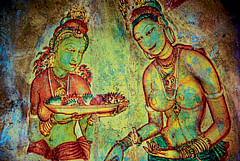
Did you know that Sanghamitra – Emperor Ashoka’s daughter had carried a cutting of the Bodhi tree to Sri Lanka in 3rd century BC? The tree was planted at the Anuradhapura district of Lanka then. Later, when the original tree in Gaya died, a cutting of the Lankan tree was brought back and planted here.
This and several such gems on Buddhism in Sri Lanka are on offer at a photo exhibition in the Capital. World-renowned archival conservationist photographer Benoy K Behl is showcasing a fascinating set of photographs at the India International Centre (IIC) titled ‘Buddhism in Sri Lanka: A great tradition shared with India.’
Indeed, Buddhism, India and Sri Lanka go back a long way. “Since the time of planting of the Bodhi tree in Lanka, both the tree and the religion have flourished there. Over the centuries, stupas, monasteries and cave paintings have come up in Sri Lanka which bear a direct resemblance with the Buddhist architecture in India.”
“In fact, not just the religious sites, even kings on the island nation followed the traditions of Buddhist rulers in India. Inspired by Ashoka, who called himself ‘Devanampiya-Piyadassi,’ a Lankan king used the name ‘Devanampiya Tissa’
(beloved of the divine) on his inscriptions.”
Benoy travelled to Lanka last year and visited almost all the important sites of Buddhist heritage. Most important of them all was, Anuradhapura in central Sri Lanka. His photographs show a large sprawling tree with prayer flags tied to its branches and heart shaped leaves. Hundreds of people are seen praying to the tree seeking the blessings of Buddha.
Other than that, Anuradhapura is also home to some magnificent stupas. The Mirisawetiya and Ruwanmalisaya Stupas of the 2nd Century BC stand tall over the Lankan horizon, a pure white against the beautiful blue of the sky.
Not far from it is Kekirawa which has the tallest Buddha statue in Lanka – Aukana Buddha – 39 feet above its lotus plinth and 46 feet above the ground. Made of an unusual almond colour rock, it was commissioned by King Dhatusena in the 5th century. Benoy says, “Brhad buddhas (larger than life statues of the Lord) began to be made at the same time in Maharashtra and Lanka.”
Polonnuruwa, east of Kekirawa, was the capital of Sri Lanka in the 11th and 12th centuries. Today, it is famous for its vatadage (circular shrine) similar to the chaitya-griha made to house objects of veneration in India. Polonnuruwa’s vatadage, built during the reign of Parakramabahu I, is believed to hold the tooth relic of Buddha.
Another site of interest documented by Benoy is the UNESCO World Heritage Site Sigiriya caves. Occupied by Buddhist monks in the 3rd century, the mural paintings herein are often compared with those at Ajanta. Depictions of innumerable apsaras (celestial maidens), carrying flowers for deities and holy beings, remind us that there is beauty and solace at the end of the sorrows of the world.